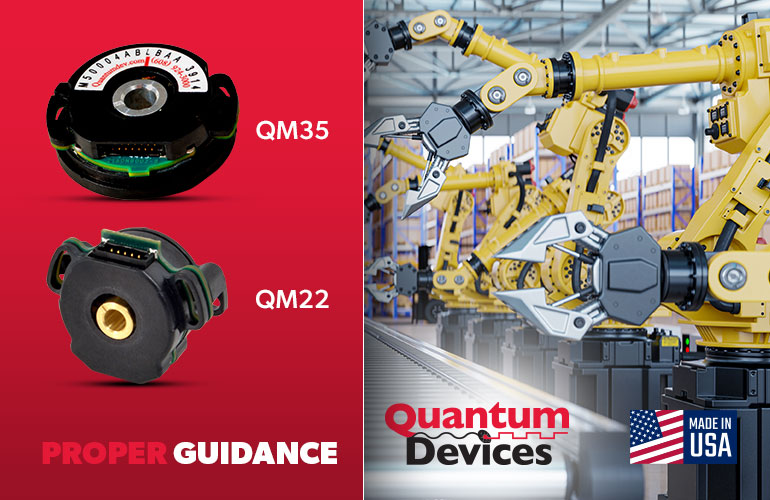|
Listen to this article |

Industry-leading Optical Encoders for High Performance Motion Control
By Mike Garibay, Sales and Marketing Manager
Encoders in Robotics
Encoders are fundamental by nature to robotics motion control as they provide accurate and precise feedback about angle, position, and speed.
The robotics industry has grown steadily in the past decade as more industries move towards automation. Robotics and automation are often used to perform tasks considered too dangerous for humans or repetitive tasks that humans can’t maintain, and the environments in which they are used frequently present very demanding engineering requirements depending on the industry.
Optical Encoders Used in Robotics
There is no one-fits-all solution for encoders used in robotics. Optical encoders are the most commonly utilized and can record in incremental or absolute measurements:
- Incremental encoders rely on a reference position to establish a starting point from which they measure.
- Absolute encoders don’t require a reference position and start measuring from the moment they are turned on.
But selecting an encoder is more complex than simply choosing between an incremental or absolute encoder.
Capabilities and Configurations for Robotics Encoders
Optical encoders used in robotics demand a small footprint, high functionality device. Robotics and automation are trending towards miniaturization, and this extends to their parts and processes. It’s important that encoders are not only small for compact robot mechanisms, but also intentionally engineered for error-free assembly and faster installation in complex machines.
Configurations for encoders in robotics are highly dependent on the range of motion, motor, and steering control. Servo motors and Brushless DC motors are both widely used. Each motor in an AGV or a robotic arm is combined with an encoder, and even a secondary encoder in some circumstances, to record angle, position, speed, and linear distance.
Optical encoders provide the ideal combination of resolution, accuracy and repeatability. Some examples of optical rotary encoder applications in robotics include:
Reliable, Accurate Encoders from Quantum Devices
At Quantum Devices, we manufacture and supply industry-leading high resolution encoders. Due to their precision and accuracy, our optical encoders are used frequently in the robotics industry to facilitate robot positioning.
Quantum Devices’ optical rotary encoders use a patented interlaced photodiode array designed to translate light intensity to electrical current with a high degree of accuracy, and greater reliability. Because of the following features, Quantum Devices’ encoders are ideal for the robotic industry.
- Low profile, assembled height
- Resolutions up to 8192 lines per revolution
- 4, 6, 8, 10 or 18 pole commutation
- Easy lock-n-twist assembly feature
- Up to 1Mhz frequency response
- High noise immunity
- RoHS construction
- Hermetically sealed LED
- Multiple mounting options
Optical Encoder Engineering Support
Since 1999, Quantum Devices has been known for innovation and customization to match our customers’ motion control requirements. We build our encoders from the ground up, with design and manufacturing on-site allowing us to offer application-specific products.
Our QM35 and QM22 are particularly popular for self-guided vehicle navigation due to their low-profile and small diameter respectively. Both models feature a bearingless modular design and offer versatile electrical configurations allowing for customization.
Quantum Devices’ engineers will provide a review of your application, or help you select the best type of optical encoder for your project.
Buy optical encoders online direct from our store or contact us to request a custom configuration.
Sponsored content by Quantum Devices
